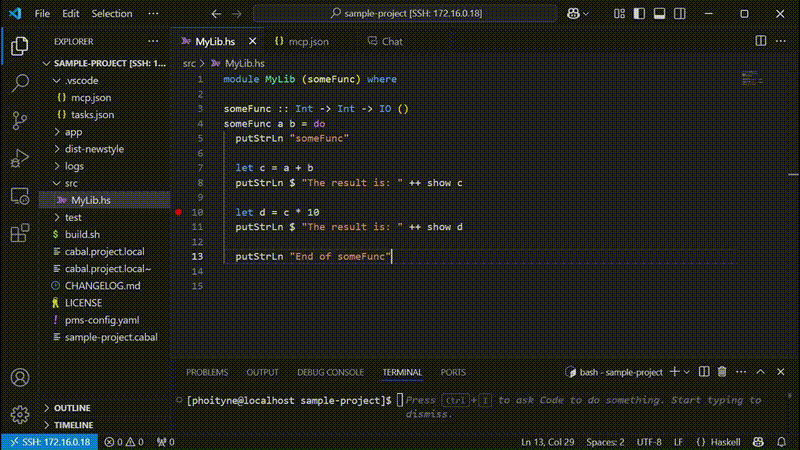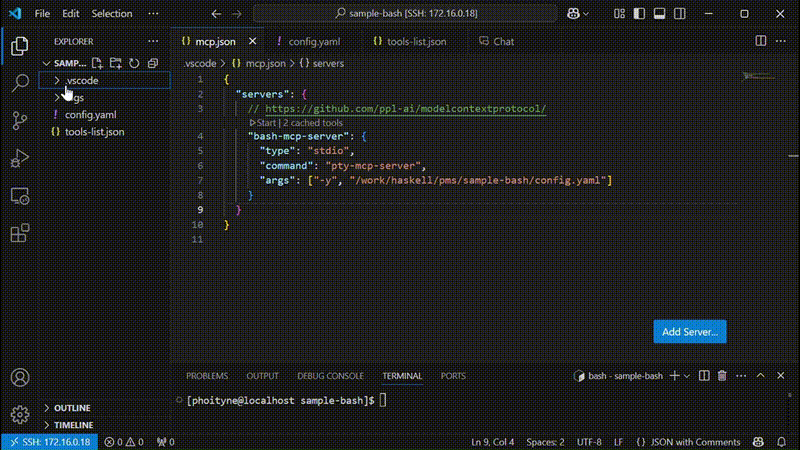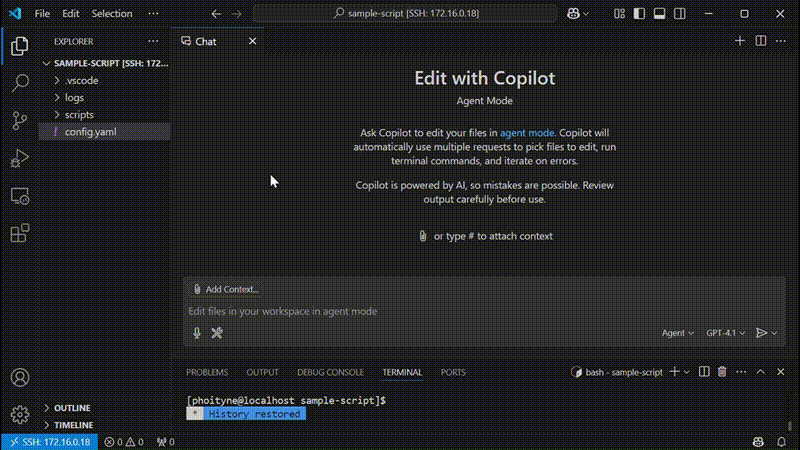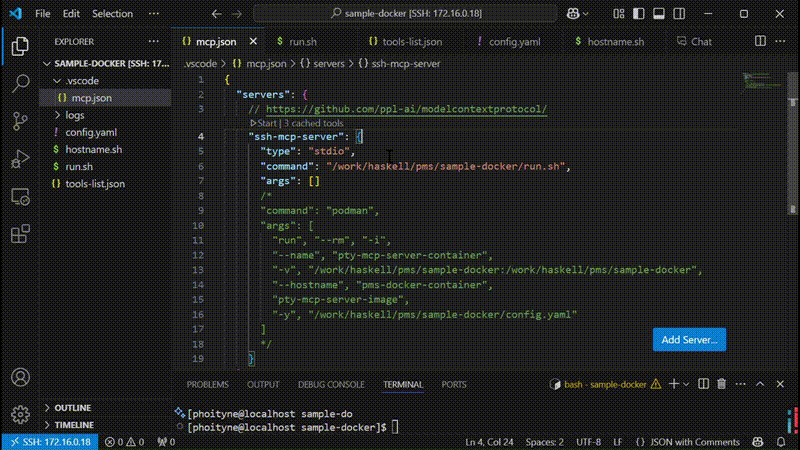pty-mcp-server
⚠️ Caution
Do not grant unrestricted control to AI.
Unsupervised use or misuse may lead to unintended consequences.
All AI systems must remain strictly under human oversight and control.
Use responsibly, with full awareness and at your own risk.
pty-mcp-server is a Haskell implementation of the MCP (Model Context Protocol),
designed to enable AI agents to acquire and control PTY (pseudo-terminal) connections dynamically.
Through MCP, AI can interact with external CLI-based tools in a structured, automated, and scriptable way,
leveraging PTY interfaces to execute tasks in real environments.
As an MCP server, pty-mcp-server operates strictly in stdio mode, communicating with MCP clients exclusively via standard input and output (stdio).
User Guide (Usage and Setup)
Features
pty-mcp-server provides the following built-in tools for powerful and flexible automation:
-
pty-connect
Launches any command through a PTY interface with optional arguments.
Great for general-purpose terminal automation.
-
pty-message
Sends input to an existing PTY session (e.g., df -k) without needing full context of the current terminal state.
Abstracts interaction in a programmable way.
-
pty-bash
Starts an interactive Bash shell (/bin/bash -i -l) in a pseudo-terminal.
Empowers AI to execute shell commands like a real user.
-
pty-ssh
Opens a remote SSH session via PTY, enabling access to remote systems.
Accepts user/host and SSH flags as arguments.
-
pty-cabal
Launches a cabal repl session within a specified project directory, loading a target Haskell file.
Supports argument passing and live code interaction.
-
pty-stack
Launches a stack repl session within a specified project directory, loading a target Haskell file.
Supports argument passing and live code interaction.
-
pty-ghci
Launches a GHCi session within a specified project directory, loading a target Haskell file.
Supports argument passing and live code interaction.
-
Scriptable CLI Integration
The pty-mcp-server supports execution of shell scripts associated with registered tools defined in tools-list.json. Each tool must be registered by name, and a corresponding shell script (.sh) should exist in the configured scripts/ directory.
This design supports AI-driven workflows by exposing tool interfaces through a predictable scripting mechanism. The AI can issue tool invocations by name, and the server transparently manages execution and interaction.
To add a new tool:
- Create a shell script named
your-tool.sh in the scripts/ directory.
- Add an entry in
tools-list.json with the name "your-tool" and appropriate metadata.
- No need to recompile or modify the server — tools are dynamically resolved by name.
This separation of tool definitions (tools-list.json) and implementation (scripts/your-tool.sh) ensures clean decoupling and simplifies extensibility.
Example Use Cases
- Performing interactive REPL operations (e.g., using GHCi or other CLI-based REPLs)
- Interactive debugging of Haskell applications
- System diagnostics through bash scripting
- Remote server management via SSH
- Dynamic execution of CLI tools in PTY environments
Requirements
- GHC >= 9.12
- Linux environment (PTY support required)
- On Windows, use within a WSL (Windows Subsystem for Linux) environment
Dependencies
This package depends on the following packages:
How to Run
The pty-mcp-server application is executed from the command line.
Usage
$ pty-mcp-server -y config.yaml
While the server can be launched directly from the command line, it is typically started and managed by development tools that integrate an MCP client—such as Visual Studio Code. These tools utilize the server to enable interactive and automated command execution via PTY sessions.
VSCode Integration: .vscode/mcp.json
To streamline development and server invocation from within Visual Studio Code, the project supports a .vscode/mcp.json configuration file.
This file defines how the pty-mcp-server should be launched in a development environment. Example configuration:
{
"servers": {
"pty-mcp-server": {
"type": "stdio",
"command": "pty-mcp-server",
"args": ["-y", "/path/to/your/config.yaml"]
}
}
}
config.yaml Configuration (ref)
-
logDir:
The directory path where log files will be saved. This includes standard output/error logs and logs from script executions.
-
logLevel:
Sets the logging level. Examples include "Debug", "Info", and "Error".
-
scriptsDir:
Directory containing script files (shell scripts named after tool names, e.g., ping.sh). If a script matching the tool name exists here, it will be executed when the tool is called.
This directory must also contain the tools-list.json file, which defines the available public tools and their metadata.
-
prompts:
A list of prompt strings used to detect interactive command prompts. This allows the AI to identify when a command is awaiting input. Examples include "ghci>", "]$", "password:", etc.
Installation
You can install pty-mcp-server using cabal:
cabal install pty-mcp-server
Running with Podman or Docker
You can build and run pty-mcp-server using either Podman or Docker.
Note: When running pty-mcp-server inside a Docker container, after establishing a pty connection, you will be operating within the container environment. This should be taken into account when interacting with the server.
1. Build the image
Clone the repository and navigate to the docker directory:
$ git clone https://github.com/phoityne/pty-mcp-server.git
$ cd pty-mcp-server/docker
$ podman build . -t pty-mcp-server-image
$
Ref : build.sh
2. Run the container
Run the server inside a container:
$ podman run --rm -i \
--name pty-mcp-server-container \
-v /path/to/dir:/path/to/dir \
--hostname pms-docker-container \
pty-mcp-server-image \
-y /path/to/dir/config.yaml
$
Ref : run.sh
Below is an example of how to configure mcp.json to run the MCP server within VSCode:
{
"servers": {
"pty-mcp-server": {
"type": "stdio",
"command": "/path/to/run.sh",
"args": []
/*
"command": "podman",
"args": [
"run", "--rm", "-i",
"--name", "pty-mcp-server-container",
"-v", "/path/to/dir:/path/to/dir",
"--hostname", "pms-docker-container",
"pty-mcp-server-image",
"-y", "/path/to/dir/config.yaml"
]
*/
}
}
}
Architecture Guide (Software Architecture and Technical Details)
Architectural Strategy
The architecture of the pty-mcp-server project is designed with medium-to-large scale systems in mind. Emphasis is placed on modularity, maintainability, and scalability, especially in environments involving multiple teams or organizations.
To achieve these goals, the system is structured as a collection of well-separated packages, each responsible for a specific concern or domain. This package-oriented design provides several strategic benefits.
The overall package structure adheres to the principles of Onion Architecture, reflecting a layered design that places the domain model at the core. Furthermore, the internal module structure within each package is also guided by a layered approach, maintaining clear separation between pure data definitions, domain services, and infrastructure concerns.
Role of pty-mcp-server as a Dependency Injector
In addition to managing REPL communication, pty-mcp-server is not merely an executable module, but also acts as a dependency injector for the entire system.
- It is capable of referencing all relevant PMS packages, including those that it depends on.
- This allows it to construct and wire together application components across multiple packages and modules in a unified manner.
- By centralizing this dependency resolution,
pty-mcp-server provides a single point of control over cross-cutting dependencies, improving visibility and control over the system architecture.
As a result, inter-package and inter-module dependencies can be centrally coordinated and managed, which promotes better encapsulation, reusability, and testability throughout the system.
Rationale for Package Separation
-
Clear Interface Definition
Each package exposes only its minimal, well-defined public API. This enforces clean module boundaries and reduces unintended dependencies between components.
-
Team and Vendor Ownership
In larger projects, different teams or external vendors can own specific packages. Clear separation ensures well-defined responsibilities and supports collaborative development across organizational boundaries.
-
Repository and Release Independence
Packages can be split into separate repositories and versioned independently. This allows for modular development and flexible release workflows, reducing build times and simplifying integration.
-
Improved Maintainability and Extensibility
By isolating concerns, the impact of code changes is limited to relevant modules. This minimizes regressions and facilitates safe, incremental improvements over time.
Intended Use Cases
- Medium-to-large scale enterprise systems involving multiple developers or teams
- Modular systems with independent development and release cycles for components
- Projects that require long-term maintainability, extensibility, and isolation of concerns
This architecture follows a layered and modular approach. Domain models, domain services, application logic, and infrastructure concerns are each encapsulated in their own package, enabling clean composition while preserving separation of responsibilities.
Deployment Diagram

Package Structure

Demo haskell cabal repl
 ref : prompt
ref : prompt
Demo bash

Demo shellscript

Demo Docker




 ref :
ref : 

